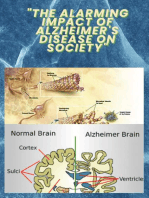Alzheimer's Brochure
Alzheimer's Brochure
Uploaded by
bluebeary22Copyright:
Available Formats
Alzheimer's Brochure
Alzheimer's Brochure
Uploaded by
bluebeary22Original Description:
Copyright
Available Formats
Share this document
Did you find this document useful?
Is this content inappropriate?
Copyright:
Available Formats
Alzheimer's Brochure
Alzheimer's Brochure
Uploaded by
bluebeary22Copyright:
Available Formats
People with Alzheimers disease have difficulty learning new information.
The disease first attacks areas of the brain that deal with learning. As the disease advances, symptoms continue to worse. These can include disorientation, mood swings, deep confusion regarding events, time, and places, memory loss, difficulty speaking, swallowing, or walking, and confusion regarding family and close friends.
In 1901, German psychiatrist Alois Alzheimer came upon the first case of what would later be called Alzheimers disease in a fifty year-old woman called Auguste D. It was then later described as a distinctive disease by Emil Kraepelin in 1910 and began to be diagnosed throughout the 20th century.
An all-inclusive guide to the terrible illness
The cause of Alzheimers is still relatively unknown, except for 1%-5% of cases, which have been linked to hereditary traits. However, scientists believe that the cause of Alzheimers could be linked with plaques and tangles. Plaques are build-ups of a protein fragment called beta-amyloid deposits in spaces between nerve cells. Tangles are twisted fibers of a protein called Tau that build up inside cells. Scientists are working to expand the hypothesis that plaques and tangles can interfere and cause a block in
Mayo Clinic Staff. "Alzheimer's Stages: How the Disease Progresses." Mayo Clinic. Mayo Clinic, n.d. Web. 09 Feb. 2014. "Alzheimer's Disease Fact Sheet." National Institute on Aging. National Institutes of Health, Sept. 2012. Web. 06 Feb. 2014. Schnabel, Jim. "Alzheimer's Disease: Return of the Prion Hypothesis." News. The Dana Foundation, 17 Feb. 2012. Web. 09 Feb. 2014.
communication between nerve cells, causing them to die. Another theory is that the disease
is caused by the reduced synthesis of neurotransmitter aceytylcholine. This hypothesis has not been widely accepted, however, because medicines treating aceytylcholine deficiencies have not been very effective.
Jenna Lee Pd. 7 2/10/14
Early-onset Alzheimers disease is inherited in an autosomal dominant pattern. This means that one copy of the affected gene will cause the disorder. Most patients with earlyonset Alzheimers inherit the gene from only one affected parent. The inheritance pattern of late-onset Alzheimers disease is unclear. However, people who inherit an affected allele have a higher risk of developing the disease. Not all people with Alzheimers have the affected allele, and not all people with the allele will develop the disease, but connections have been made between the inheritance of the allele and the development of the disease.
Since no cure to the disease exists. Alzheimers is currently only treatable on a symptombasis. Drugs are often prescribed to regulate neurotransmitters, which are the chemicals that transmit messages between neurons. However, these drugs do not prevent the advancement of the disease and are only effective for some people. The National Institute of Health is the lead federal establishment for Alzheimers research. These scientists are testing new drugs in attempts to treat symptoms, slow the disease, or even prevent Alzheimers all together. No single test exists to prove that a person has Alzheimers. Alzheimers is only diagnosable through a complete assessment studying many different traits.
In the 1970s and 19080s, scientists noticed similarities between Alzheimers and transmissible spongiform encephalopathies like scrapie and CJd (Creutzfeldt-Jakob disease). Both seemed to be connected to the protein deposits called amyloids. In both Alzheimers and TSE, sponge-like holes have been found in patients. Recent experiments have shown that Alzheimers could be caused by an infection-like spread of protein aggregates in the brain, and could be a weakly-transmissible prion disease, just like TSEs. Scientists have found evidence that aggregates of Tau and amyloids being able to spread in a prion-like manner from cell to cell. They have done experiments, implanting diseased brain cells into mice, and found that the Alzheimers disease may possibly be able to be transmitted.
The greatest risk factor for Alzheimers is old age. Most patients with the disease are over the age of 65. The probability of developing Alzheimers doubles about every five years after the age of 65. After the age of 85, the risk of developing the disease reaches almost fifty percent. Another strong risk factor is family history. Patients with an immediate family member who has Alzheimers are much more likely to develop the disease. The risk increases as a person has more family members with the illness.
Five stages of Alzheimers exist. 1. Preclinical Alzheimers Disease: symptoms do not emerge during this stage, however early deposits of amyloid beta may be developing. 2. Mild Cognitive Impairment: in this stage, people have mild changes to their memory and thinking abilities. 3. Mild Dementia: Alzheimers is typically diagnosed in this stage. Patients begin to experience memory loss of recent events, confusion, and changes in personality. 4. Moderate Dementia: During this stage, patients become increasingly confused and need help with daily activities. 5. Severe Dementia: patients with severe dementia lose the ability to communicate coherently, require daily assistance with personal care, and experience a decline in physical activities.
Tau Protein
Beta-amyloid Protein
There is currently no existing cure for Alzheimers disease, but drugs are being produced to help with mental and behavioral symptoms. Researchers are studying medications to deal with memory loss, behavior, and sleep changes that come with Alzheimers
You might also like
- AlzheimerDocument11 pagesAlzheimerSoniya G08No ratings yet
- Survey InstrumentDocument2 pagesSurvey InstrumentDonna Grace Herman100% (7)
- Sulakshana Leo HarrisDocument6 pagesSulakshana Leo HarrisSulakshana Dhungel100% (1)
- Practical Child Psychiatry - Clinician's Guide - B. Lask, S. Taylor, K. Nunn (BMJ, 2003) WWDocument396 pagesPractical Child Psychiatry - Clinician's Guide - B. Lask, S. Taylor, K. Nunn (BMJ, 2003) WWamaandrei100% (1)
- Od Intervention With Case StudiesDocument13 pagesOd Intervention With Case StudiesArushi Kaul78% (9)
- Your Guide to Health: Alzheimer's: Reliable Information for Patients and Their FamiliesFrom EverandYour Guide to Health: Alzheimer's: Reliable Information for Patients and Their FamiliesNo ratings yet
- Alziehmer SeminarDocument15 pagesAlziehmer Seminarsantosh kumarNo ratings yet
- AlzheimerDocument8 pagesAlzheimerapi-379370435100% (1)
- BurchGene Džana MulaomerovićDocument3 pagesBurchGene Džana MulaomerovićAhmed OsmanovicNo ratings yet
- Alzheimer'S Research PapeDocument11 pagesAlzheimer'S Research PapeAnonymous yQQKF5qLiRNo ratings yet
- Alzheimer's Care - The Caregiver's Guide to Understanding Alzheimer's Disease & Best Practices to Care for People with Alzheimer's & DementiaFrom EverandAlzheimer's Care - The Caregiver's Guide to Understanding Alzheimer's Disease & Best Practices to Care for People with Alzheimer's & DementiaRating: 1 out of 5 stars1/5 (1)
- Thesis Statement On Alzheimers DiseaseDocument7 pagesThesis Statement On Alzheimers Diseasegbwygt8n100% (1)
- Alzheimer Cover Page (Hard Cover)Document21 pagesAlzheimer Cover Page (Hard Cover)seanfaria100% (1)
- Levi Santana, R.N. Bulacan State University College of NursingDocument66 pagesLevi Santana, R.N. Bulacan State University College of NursingMary Grace MasNo ratings yet
- AlzheimersDocument9 pagesAlzheimersNader Smadi100% (1)
- The Basics of Alzheimer's Disease: Dipil PatelDocument15 pagesThe Basics of Alzheimer's Disease: Dipil Patelgore-patelNo ratings yet
- Passage 1. AlzheimerDocument1 pagePassage 1. AlzheimerRaana R. SherwaniNo ratings yet
- Alzheimer's DiseaseDocument14 pagesAlzheimer's DiseaseHadiNo ratings yet
- Alzheimer'sDocument11 pagesAlzheimer'sdianaNo ratings yet
- Alzhymas DiseaseDocument12 pagesAlzhymas Diseasekids dance BNo ratings yet
- Effects of The Alzheimer's Disease/ Essay / PaperDocument5 pagesEffects of The Alzheimer's Disease/ Essay / PaperAssignmentLab.comNo ratings yet
- Enf Alzheimer RevisionDocument8 pagesEnf Alzheimer RevisionLuis Collar ViñuelasNo ratings yet
- Alzheimer's Disease Treatment - GIOSTARDocument3 pagesAlzheimer's Disease Treatment - GIOSTARGIOSTAR Stem CellsNo ratings yet
- Alzheimer'S Disease: Miss Sana HanifDocument27 pagesAlzheimer'S Disease: Miss Sana HanifDr-umar AliNo ratings yet
- AlzheimerDocument6 pagesAlzheimerCharlie CansteinNo ratings yet
- Alzheimer: Simple Yet Complex: Symptoms of This Disorder Are As FollowsDocument2 pagesAlzheimer: Simple Yet Complex: Symptoms of This Disorder Are As FollowsNeha RastogiNo ratings yet
- Alzheimer's DiseaseDocument20 pagesAlzheimer's DiseaseHariharanPillaiNo ratings yet
- Alzheimers DiseaseDocument5 pagesAlzheimers Diseaseapi-309590964No ratings yet
- A LZHEIMER'SDocument9 pagesA LZHEIMER'SPaul Mark PilarNo ratings yet
- Alzheimers Disease Research Paper ThesisDocument6 pagesAlzheimers Disease Research Paper Thesisgw0pajg4100% (1)
- Understanding Alzheimer's and DementiaDocument16 pagesUnderstanding Alzheimer's and DementiaWaltWritman100% (1)
- Research Paper Topics On Alzheimers DiseaseDocument6 pagesResearch Paper Topics On Alzheimers Diseasefvehwd96100% (1)
- Alzheimers Disease Research PaperDocument7 pagesAlzheimers Disease Research PaperIsaiah DiggsNo ratings yet
- To Start Off, When Was Is Discovered?: 906: Dr. Alois Alzheimer First Describes "A Peculiar Disease"Document5 pagesTo Start Off, When Was Is Discovered?: 906: Dr. Alois Alzheimer First Describes "A Peculiar Disease"darkseifert100% (1)
- Write Research Paper Alzheimers DiseaseDocument5 pagesWrite Research Paper Alzheimers Diseaseuyqzyprhf100% (1)
- Alzheimer's Disease: Causes, Symptoms and TreatmentsDocument5 pagesAlzheimer's Disease: Causes, Symptoms and Treatmentsfaradilla ramadaniNo ratings yet
- Alzheimer's Disease: Fact SheetDocument5 pagesAlzheimer's Disease: Fact Sheetmauricejacq76No ratings yet
- BS NursingDocument5 pagesBS NursingDenise Louise PoNo ratings yet
- Research Paper Over Alzheimers DiseaseDocument5 pagesResearch Paper Over Alzheimers Diseasep0womafasyb2100% (1)
- Document 2Document5 pagesDocument 2api-355999814No ratings yet
- Boala AlzheimerDocument7 pagesBoala AlzheimerGeorgiana MarinacheNo ratings yet
- Demensia Vs AlzheimerDocument16 pagesDemensia Vs AlzheimerUmmu ZaFaNo ratings yet
- Alzheimer Disease - Risks, Symptoms and Related TestsDocument15 pagesAlzheimer Disease - Risks, Symptoms and Related TestsMishelaNo ratings yet
- Research Paper Topics AlzheimersDocument4 pagesResearch Paper Topics Alzheimerspukjkzplg100% (1)
- Alzheimers - Association - Topics - 12 - 10 - 2019 2 PDFDocument34 pagesAlzheimers - Association - Topics - 12 - 10 - 2019 2 PDFRonnie MalletNo ratings yet
- What Is DementiaDocument24 pagesWhat Is DementiaJorey QuietaNo ratings yet
- What Is It Behind Alzheimer's Disease? A Pathophysiology ReviewDocument8 pagesWhat Is It Behind Alzheimer's Disease? A Pathophysiology ReviewAnonymous 4iaWWhhDU8No ratings yet
- Alzheimer's Disease OverviewDocument13 pagesAlzheimer's Disease OverviewRaj Kumar Byadwal 5-Yr IDD Civil Engg., IIT(BHU), VaranasiNo ratings yet
- AlzheimerDocument1 pageAlzheimerKibet ElishaNo ratings yet
- Alzheimer'S Disease: Amoranto - Azugue - Bamba - Caser - Nhiyam - RaymundoDocument34 pagesAlzheimer'S Disease: Amoranto - Azugue - Bamba - Caser - Nhiyam - RaymundoRia り あ HitsugayaNo ratings yet
- Alzheimer'S Disease: Is A Progressive and Fatal Brain Disease. More Than 5 Million Americans Now HaveDocument7 pagesAlzheimer'S Disease: Is A Progressive and Fatal Brain Disease. More Than 5 Million Americans Now Havebored_stiffNo ratings yet
- Research Paper On Alzheimers DiseaseDocument7 pagesResearch Paper On Alzheimers Diseasexjcwzfrif100% (1)
- ALZHEIMERSDocument16 pagesALZHEIMERSKathleen DiangoNo ratings yet
- Summary & Study Guide - The Alzheimer's Solution: A Breakthrough Program to Prevent and Reverse Cognitive Decline at Every AgeFrom EverandSummary & Study Guide - The Alzheimer's Solution: A Breakthrough Program to Prevent and Reverse Cognitive Decline at Every AgeNo ratings yet
- Case Study of Alzheimer's DementiaDocument4 pagesCase Study of Alzheimer's DementiaKaesun Song DouglasNo ratings yet
- What Is DementiaDocument5 pagesWhat Is DementiaIuly ManacNo ratings yet
- Brochure Basicsofalz LowDocument28 pagesBrochure Basicsofalz LowIbrahim HalilovicNo ratings yet
- Alzheimers Case StudyDocument4 pagesAlzheimers Case Studygamecockusc1992No ratings yet
- Causes and Risk Factors of Alzheimer's DiseaseDocument5 pagesCauses and Risk Factors of Alzheimer's DiseaseAnisa Ayu MaharaniNo ratings yet
- Alzheimer's Disease: January 2021Document4 pagesAlzheimer's Disease: January 2021sara salamaNo ratings yet
- AlzheimerDocument4 pagesAlzheimerkmshahd3No ratings yet
- Alzheimer's Disease Fact Sheet: Symptoms DementiaDocument16 pagesAlzheimer's Disease Fact Sheet: Symptoms DementiaJovelyn Morales JosolNo ratings yet
- The Causes and Effects of Alzheimer's Disease: The Silent DiseaseDocument35 pagesThe Causes and Effects of Alzheimer's Disease: The Silent DiseaseNina Canares100% (2)
- النمو النفسي الاجتماعي لدى طفل متلازمة داون تبعا لبعض المتغيرات (الجنس، درجة الاعاقة)Document14 pagesالنمو النفسي الاجتماعي لدى طفل متلازمة داون تبعا لبعض المتغيرات (الجنس، درجة الاعاقة)amel khattabiNo ratings yet
- MGT502 Quiz-1 by Vu Topper RMDocument35 pagesMGT502 Quiz-1 by Vu Topper RMafiabashir762No ratings yet
- 8601 Assignment No.1Document17 pages8601 Assignment No.1ebaadmalik653No ratings yet
- HKHDocument45 pagesHKHRahardian Gusta PatriaNo ratings yet
- Conduct DisorderDocument7 pagesConduct DisorderSenka Nenadov100% (1)
- Peer Pressure: The Causes of Teenage Pregnancy in The PhilippinesDocument3 pagesPeer Pressure: The Causes of Teenage Pregnancy in The PhilippinesSamantha Cheska100% (1)
- Dysmorphic DisorderDocument2 pagesDysmorphic DisorderKurt NicolasNo ratings yet
- SPS 143 Psychology 3 (Question and Answer)Document10 pagesSPS 143 Psychology 3 (Question and Answer)Qistina ShahrilNo ratings yet
- Meditation Programs: Heart-CenteredDocument4 pagesMeditation Programs: Heart-CenteredAnonymous BaszMDONo ratings yet
- Assessment Nursing Diagnosis Planning Intervention Rationale EvaluationDocument3 pagesAssessment Nursing Diagnosis Planning Intervention Rationale Evaluationrocs De GuzmanNo ratings yet
- Assignment - Functions of HRMDocument16 pagesAssignment - Functions of HRMMd Shawfiqul Islam100% (1)
- Chapter 1THE FACTORS AFFECTING THE CAREER DECISION OF GRADE 11 GAS STUDENTS IN SAINT VINCENT COLLEGE OF CABUYAODocument7 pagesChapter 1THE FACTORS AFFECTING THE CAREER DECISION OF GRADE 11 GAS STUDENTS IN SAINT VINCENT COLLEGE OF CABUYAOJusdtrou Añeperbos100% (1)
- Mindful Month Calendar PDFDocument1 pageMindful Month Calendar PDFDomingo Juan de LeónNo ratings yet
- Delaguiado (Jen and Mark Case)Document3 pagesDelaguiado (Jen and Mark Case)kalietuiNo ratings yet
- NPIDocument4 pagesNPIKim Franzel M. RabeNo ratings yet
- Lindsey D BaumannDocument4 pagesLindsey D Baumannapi-249095187No ratings yet
- Basic Principles of Psychiatric NursingDocument5 pagesBasic Principles of Psychiatric NursingJo C Cuilan100% (1)
- Lazarus Interactional ModelDocument15 pagesLazarus Interactional ModelReglos Sakura ShaineNo ratings yet
- Its Ok To Be Not OkDocument3 pagesIts Ok To Be Not Okaxelh.somprequeNo ratings yet
- Nama: Aldava Rizki Anjasmara Kelas: XI IPA 5Document3 pagesNama: Aldava Rizki Anjasmara Kelas: XI IPA 5Aldava RizkiNo ratings yet
- 0 - Rubrics For Event Execution Peer TeacherDocument2 pages0 - Rubrics For Event Execution Peer TeacherSHAINA MAE DULINNo ratings yet
- Thandeka, Learning To Be White: Money, Race, and God in America (New York: Continuum International Publishing Group, 1999), 169 PPDocument2 pagesThandeka, Learning To Be White: Money, Race, and God in America (New York: Continuum International Publishing Group, 1999), 169 PPFefa LinsNo ratings yet
- Zul Ainun Aminah. YF, 160203165, FTK, PBI, 082331434285Document101 pagesZul Ainun Aminah. YF, 160203165, FTK, PBI, 082331434285julika pasaribuNo ratings yet
- Neuropsychology Dissertation TopicsDocument8 pagesNeuropsychology Dissertation TopicsCustomizedPaperPortland100% (1)
- Overcoming Blocks, Fears and InsecuritiesDocument69 pagesOvercoming Blocks, Fears and Insecuritiesunitylifecoach100% (1)
- Drug Ed.Document11 pagesDrug Ed.Bimboy Cueno100% (1)

























































































